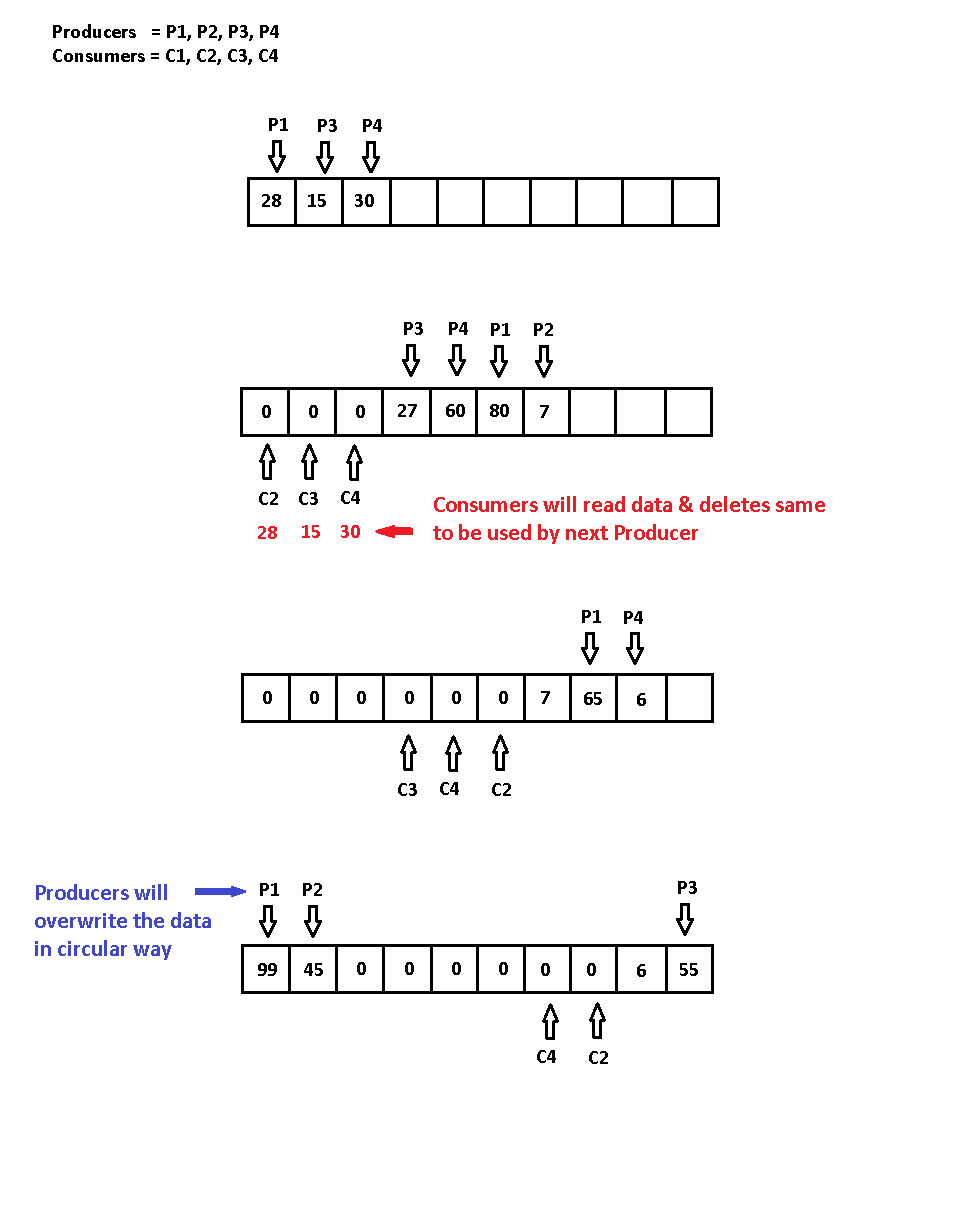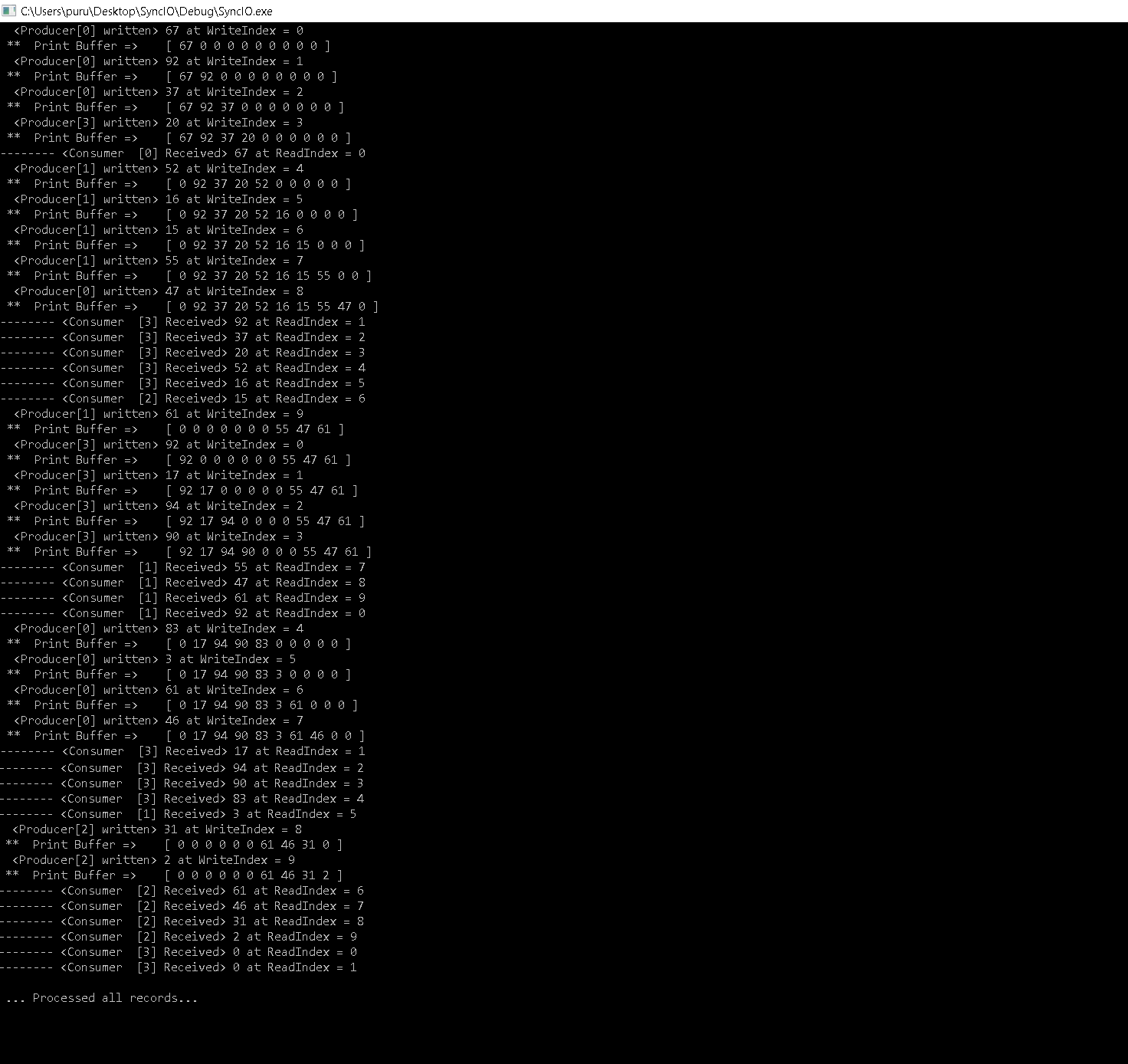Implementation of Synchronous Bounded Buffer used in Produce Consumer problem.
The intent of this program is to synchronize the Bounded buffer which is used in Producer-Consumer problem to avoid possible deadlock and race condition. So main focus is on how Bounded buffer can be synchronized? This code does not covers real Producer/Consumer process creation part like fork() or Shared memory creating system calls purposefuly.
- In classical Producer-Consumer problem, if consumer wants to read data from shared memory like fixed length resource buffer, the Consumer cannot read data before the data is produced by Producer. And same way the Producer cannot overwrite data before the data is consumed by Consumer. It requires signaling mechanism for both Consumer and Producer to complete there operation.
- Also if multiple Producers writing data and multiple Consumers reading data from shared Buffer then there is always race for data. And also it requires proper ordering of read/write operation.
This problem can be solved by using 2 Semaphores. One is for Producer with Max length and one for Consumer with Zero length. Current implementation includes C++11 supported features like std::thread and std::mutex, however semaphore is not proveded by standard library, so new class CSemaphore is created using std::mutex and std::condition_variable. Also each Producer/Consumer is simulated to run on seperate thread.
Following is the psudo code of important parts of this program.
int Buffer[N]; //Max. N resources.
CSemaphore semEmpty(0);
CSemaphore semFull(N);
int in=0, out=0; //Write index and Read index.
Mutex mlock; //For mutual exclusive access to shared bufferConsider there are multiple Producers writting in to the Buffer one at a time. Each one is waiting on 'semFull' semaphore which is initialized with N free positions. Initially the wait() call executed and it will decrement resource count by one, untill free positions available into the Buffer. And then acquire lock, write data in current free position, increment write index and finally signal to 'semEmpty' semaphore on which Consumers are waiting for data to be read from the Buffer.
Producer
{
//Each Producer writes data in tight loop.
Write(int data)
{
//Wait on 'semFull' semaphore for Consumer to read data if Buffer is Full.
semFull.wait();
// Get mutual exclusive access to buffer
mlock.lock();
//Produce data at Write index and increment index for next write operation
Buffer[in] = data;
in = (in + 1) % N;
//Unlock Mutex and signal the 'semRead' semaphore for Consumer to read data.
Mutex.unlock();
semEmpty.signal();
}
} Initially Consumers are waiting on 'SempEmpty' semaphore because it is initialized with Zero resources i.e. initially Buffer is empty. Once data is written by Producer and signalled by 'SempEmpty.signal()' call, which in turn increment available resource count. Then one of the waiting Consumer will get chance and 'semEmpty.wait()' executed which reduces resource count by one. And then acquire lock, read data, increment read index and finally call 'semFull.signal()' to signal one of the waiting Producer indicating that one position is free now to overwrite the data into Buffer.
Consumer
{
//Each Consumer reads data from Buffer in tight loop.
Read(int & readData)
{
//Wait on 'semEmpty' semaphore for Producer to write data if Buffer is Empty.
semEmpty.wait();
// Get mutual exclusive access to buffer
mlock.lock();
//Consume data at Read index and increment index for next read operation
readData = Buffer[out];
out = (out + 1) % N;
//Unlock Mutex and signal the 'semWrite' semaphore for Producer to write data.
Mutex.unlock();
semFull.signal();
}
}Following screen shot visualize the working of this program.
For better understanding, maximum 20 records are used to be processed by 4 different Producers and Consumers. See the screen shot of executable below,

